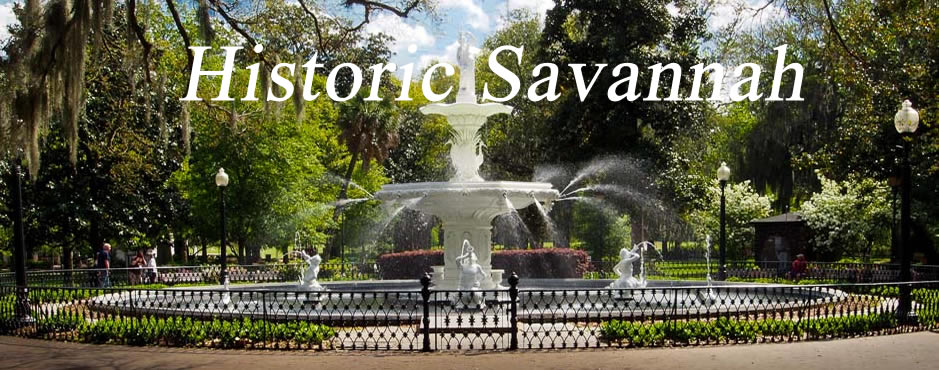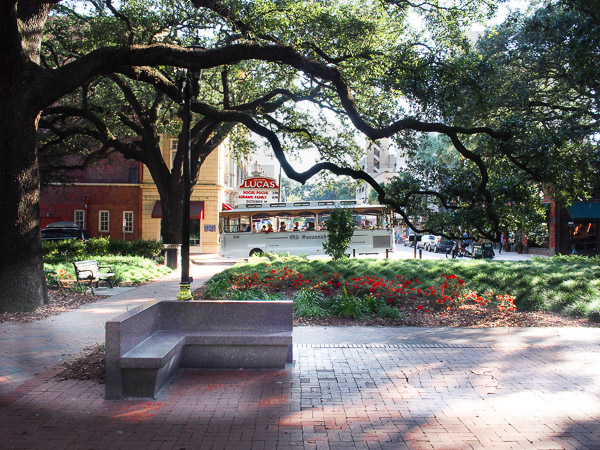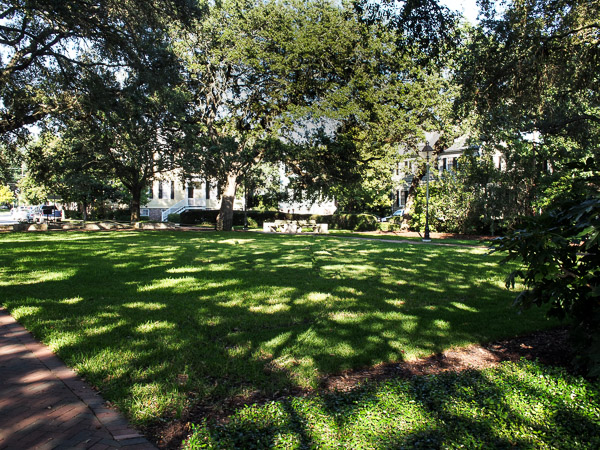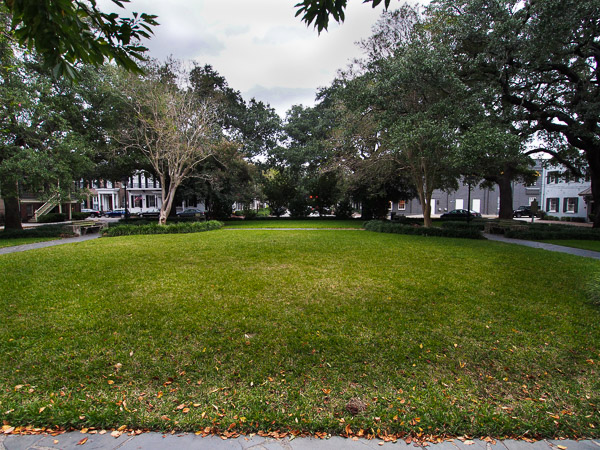Franklin Square to Washington Square
(6 Squares)
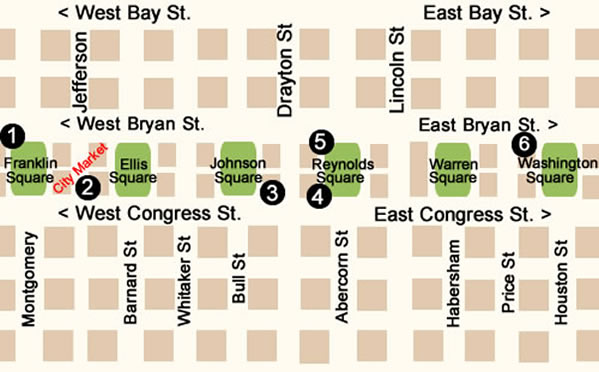
W. Bryan to E. Bryan Street (6 Squares)
Points of Interest:
Franklin Square
- Chasseurs-Volontaires de Saint-Domingue Monument - Center of Franklin Square
Ellis Square
- Johnny Mercer Sculpture
- Dancing Fountains
Johnson Square *****
- Nathanael Greene Monument - Center of Johnson Square
Reynolds Square
- John Wesley Monument - Center of Reynolds Square
Warren Square
- George Basil Spencer House - 22 Habersham Street (near Warren Square)
Washington Square
Franklin Square
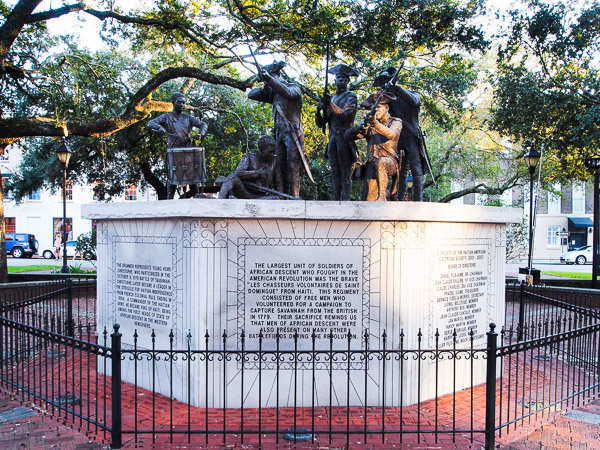 Chasseurs volontaires de Saint-Domingue Monument
Chasseurs volontaires de Saint-Domingue Monument
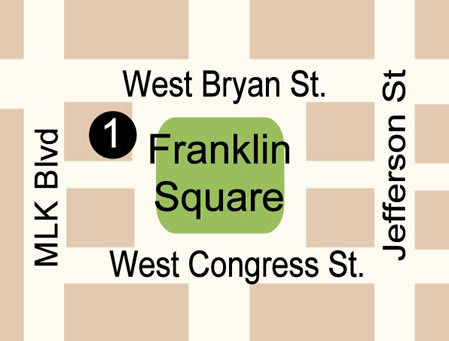
Points of Interest
 First African Baptist Church - 23 Montgomery Street
First African Baptist Church - 23 Montgomery Street
- Chasseurs-Volontaires de Saint-Domingue Monument - Center of Franklin Square
Franklin Square was established in 1790 along Montgomery Street between Congress Street and Bryan Street and was named after Benjamin Franklin.
On the west side of the square at 23 Montgomery Street is the First African Baptist Church, recognized as the oldest black Christian congregation in the country. The church was organized in 1788, 12 years before the first Baptist church for whites was built in Savannah.
Franklin Square was destroyed in 1935 when Montgomery Street became a federal route, but the square and much of the surrounding area were restored in the 1980s to commemorate the 250th anniversary of the founding of Georgia.
Ellis Square
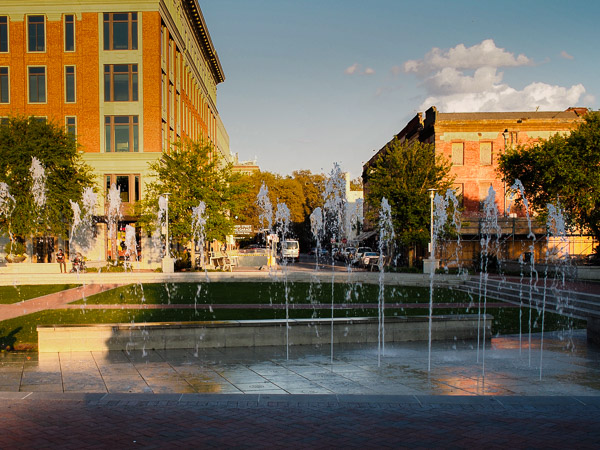
Water fountain for children to play
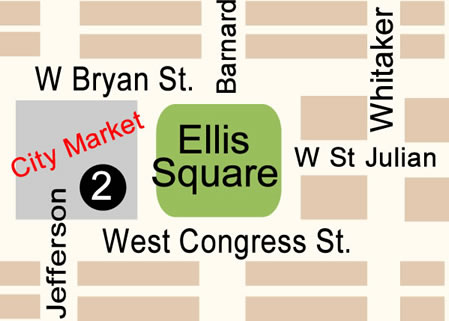
Points of Interest
- Johnny Mercer
- Dancing Fountains
Ellis Square , the city's second largest, was among the first four squares plotted by James Edward Oglethorpe in 1733. It was named for Sir Henry Ellis, Georgia's second royal governor. It is located on Barnard between Bryan and Congress Streets.
Since 1872, it was home to the City Market where farmers sold crops directly to shoppers. It was also known as Marketplace Square because it was the center of commerce from the 1730's through the 1950's. Prior to Union General Sherman's arrival in December 1864 it was also the site of a slave market.
In 1954 Ellis Square was demolished to make way for a new four-story parking garage. This loss motivated the citizens to organize Savannah's historic preservation movement and today Ellis Square has been resurrected. The city spent nearly $32 million and more than four years bringing back the 1.5-acre square.
The fountains in Ellis Square are probably the most modern in the Squares. Shooting water straight up into the air from underground, the jets of water dance around in random patterns. At night, the lights are turned on the fountain, making the jets of water colorful. Most nights the fountain is turned off at 10:00p.
On the west side of Ellis Square is a small sculpture of Johnny Mercer.
Johnson Square *****
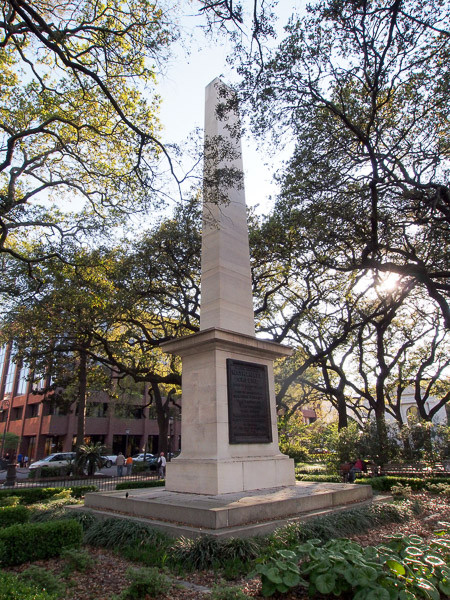
Monument to Maj. Gen. Nathanael Greene

Points of Interest
 Christ Church - 28 Bull Street
Christ Church - 28 Bull Street
- Nathanael Greene Monument - Center of Johnson Square
Johnson Square was laid out in 1733 and was the first of the original squares and is still the largest. Johnson Square is located on Bull, between Bryan and Congress Streets.
Johnson Square has two fountains and a sundial. The original sundial was replaced in 1933 and it still sits today on the south side of the square. You can also find a plaque and mosaic map of the early city in Johnson Square. There is also a white marble bench in Johnson Square which pays tribute to Johnny Mercer, Savannah's popular and successful songwriter.
Johnson Square contains a tall white obelisk memorializing the Revolutionary War hero Nathanael Greene. The cornerstone was laid in 1825. Greene, who was originally buried in the Colonial Park Cemetery, was re-interred under this monument in 1902.
On the east side of Johnson Square is the Christ Church (now known as Christ Episcopal Church), called the Mother Church of Georgia. This was the first church in historic Savannah.
Another landmark of Johnson Square includes the Johnson Square Business Center. This building, formerly known as the Savannah Bank Building, was the city's first "skyscraper", built in 1911. Johnson square is known as the financial district, or banking square, and many of the City's financial services companies are located here
Reynolds Square
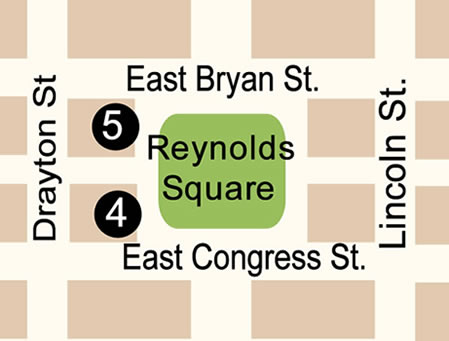
Points of Interest
 Pink House - 23 Abercorn Street
Pink House - 23 Abercorn Street
 Oliver Strugis House - 27 Abercorn Street
Oliver Strugis House - 27 Abercorn Street
- John Wesley Monument - Center of Reynolds Square
Reynolds Square was laid out in 1734 and was named for Capt. John Reynolds, governor of Georgia in the mid-1750's. A bronze statue honoring John Wesley, founder of Methodism stands in the center of the square. It is located on Abercorn, between Bryan and Congress Streets.
Also found on Reynolds Square is the Lucas Theater, located at 22 Abercorn Street. This theater was built in 1921 and was originally designed for silent films and vaudeville and was eventually refitted for talkies. It was about to be demolished until a public-private partnership was formed to modernize and restore it.
Warren Square
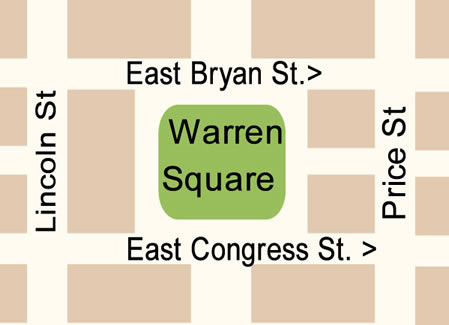
Points of Interest
- George Basil Spencer House - 22 Habersham Street (near Warren Square)
Warren Square was laid out after the final departure of James Oglethorpe and after the American Revolution in 1790. This square was named for General Joseph Warren, a Revolutionary War hero who was killed at the Battle of Bunker Hill. Warren Square is located on Habersham, between Bryan and Congress Streets. There are a number of historical homes near Warren Square. Many homes which were threaten with demolition were brought to Warren Square.
At 22 Habersham Street near Warren Square, George Basil Spencer had a post-colonial home built sometime after 1790 and before 1804. This was one of the most elaborate houses of its day.
Washington Square
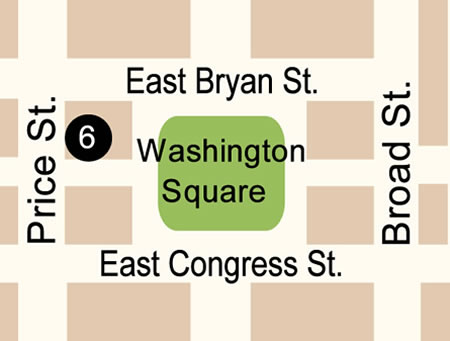
Points of Interest
 Hampton Lillibridge House - 507 East Saint Julian Street
Hampton Lillibridge House - 507 East Saint Julian Street
Washington Square was one of several new squares that came along in a quick succession after the American Revolution. Built in 1790, Washington Square was named in 1791 for the first President of the United States. Washington Square is located on Houston, between Bryan and Congress Streets.
There are a number of interesting homes in this area. Almost every home on Washington Square and the immediately surrounding streets has been owned by a person or family of historical interest or has some unique attribute, such as having been moved from another location or rebuilt in the late 1900s in order to preserve it.
